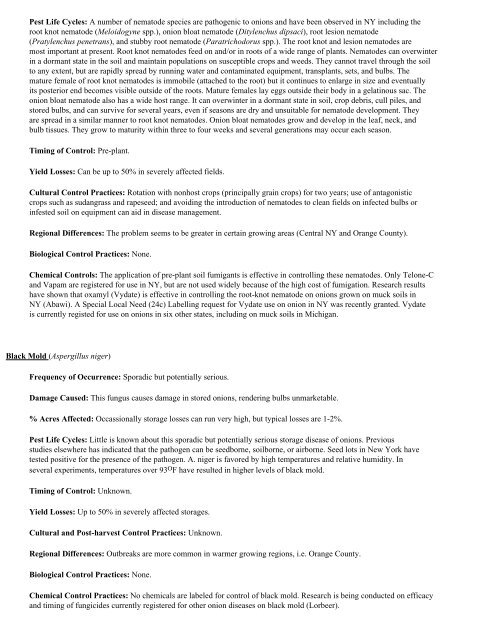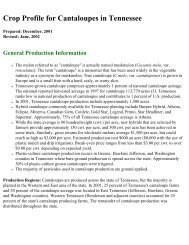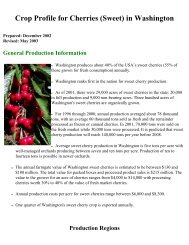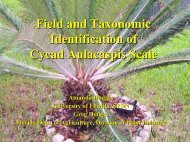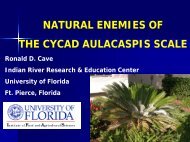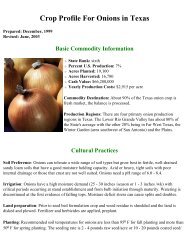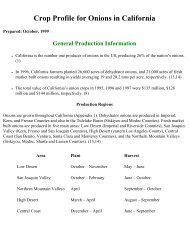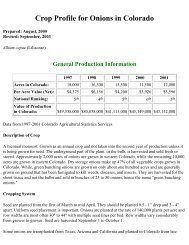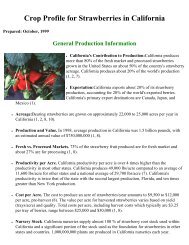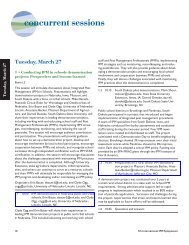Crop Profile for Onions in New York - Regional IPM Centers
Crop Profile for Onions in New York - Regional IPM Centers
Crop Profile for Onions in New York - Regional IPM Centers
Create successful ePaper yourself
Turn your PDF publications into a flip-book with our unique Google optimized e-Paper software.
Pest Life Cycles: A number of nematode species are pathogenic to onions and have been observed <strong>in</strong> NY <strong>in</strong>clud<strong>in</strong>g the<br />
root knot nematode (Meloidogyne spp.), onion bloat nematode (Ditylenchus dipsaci), root lesion nematode<br />
(Pratylenchus penetrans), and stubby root nematode (Paratrichodorus spp.). The root knot and lesion nematodes are<br />
most important at present. Root knot nematodes feed on and/or <strong>in</strong> roots of a wide range of plants. Nematodes can overw<strong>in</strong>ter<br />
<strong>in</strong> a dormant state <strong>in</strong> the soil and ma<strong>in</strong>ta<strong>in</strong> populations on susceptible crops and weeds. They cannot travel through the soil<br />
to any extent, but are rapidly spread by runn<strong>in</strong>g water and contam<strong>in</strong>ated equipment, transplants, sets, and bulbs. The<br />
mature female of root knot nematodes is immobile (attached to the root) but it cont<strong>in</strong>ues to enlarge <strong>in</strong> size and eventually<br />
its posterior end becomes visible outside of the roots. Mature females lay eggs outside their body <strong>in</strong> a gelat<strong>in</strong>ous sac. The<br />
onion bloat nematode also has a wide host range. It can overw<strong>in</strong>ter <strong>in</strong> a dormant state <strong>in</strong> soil, crop debris, cull piles, and<br />
stored bulbs, and can survive <strong>for</strong> several years, even if seasons are dry and unsuitable <strong>for</strong> nematode development. They<br />
are spread <strong>in</strong> a similar manner to root knot nematodes. Onion bloat nematodes grow and develop <strong>in</strong> the leaf, neck, and<br />
bulb tissues. They grow to maturity with<strong>in</strong> three to four weeks and several generations may occur each season.<br />
Tim<strong>in</strong>g of Control: Pre-plant.<br />
Yield Losses: Can be up to 50% <strong>in</strong> severely affected fields.<br />
Cultural Control Practices: Rotation with nonhost crops (pr<strong>in</strong>cipally gra<strong>in</strong> crops) <strong>for</strong> two years; use of antagonistic<br />
crops such as sudangrass and rapeseed; and avoid<strong>in</strong>g the <strong>in</strong>troduction of nematodes to clean fields on <strong>in</strong>fected bulbs or<br />
<strong>in</strong>fested soil on equipment can aid <strong>in</strong> disease management.<br />
<strong>Regional</strong> Differences: The problem seems to be greater <strong>in</strong> certa<strong>in</strong> grow<strong>in</strong>g areas (Central NY and Orange County).<br />
Biological Control Practices: None.<br />
Chemical Controls: The application of pre-plant soil fumigants is effective <strong>in</strong> controll<strong>in</strong>g these nematodes. Only Telone-C<br />
and Vapam are registered <strong>for</strong> use <strong>in</strong> NY, but are not used widely because of the high cost of fumigation. Research results<br />
have shown that oxamyl (Vydate) is effective <strong>in</strong> controll<strong>in</strong>g the root-knot nematode on onions grown on muck soils <strong>in</strong><br />
NY (Abawi). A Special Local Need (24c) Labell<strong>in</strong>g request <strong>for</strong> Vydate use on onion <strong>in</strong> NY was recently granted. Vydate<br />
is currently registed <strong>for</strong> use on onions <strong>in</strong> six other states, <strong>in</strong>clud<strong>in</strong>g on muck soils <strong>in</strong> Michigan.<br />
Black Mold (Aspergillus niger)<br />
Frequency of Occurrence: Sporadic but potentially serious.<br />
Damage Caused: This fungus causes damage <strong>in</strong> stored onions, render<strong>in</strong>g bulbs unmarketable.<br />
% Acres Affected: Occassionally storage losses can run very high, but typical losses are 1-2%.<br />
Pest Life Cycles: Little is known about this sporadic but potentially serious storage disease of onions. Previous<br />
studies elsewhere has <strong>in</strong>dicated that the pathogen can be seedborne, soilborne, or airborne. Seed lots <strong>in</strong> <strong>New</strong> <strong>York</strong> have<br />
tested positive <strong>for</strong> the presence of the pathogen. A. niger is favored by high temperatures and relative humidity. In<br />
several experiments, temperatures over 93 O F have resulted <strong>in</strong> higher levels of black mold.<br />
Tim<strong>in</strong>g of Control: Unknown.<br />
Yield Losses: Up to 50% <strong>in</strong> severely affected storages.<br />
Cultural and Post-harvest Control Practices: Unknown.<br />
<strong>Regional</strong> Differences: Outbreaks are more common <strong>in</strong> warmer grow<strong>in</strong>g regions, i.e. Orange County.<br />
Biological Control Practices: None.<br />
Chemical Control Practices: No chemicals are labeled <strong>for</strong> control of black mold. Research is be<strong>in</strong>g conducted on efficacy<br />
and tim<strong>in</strong>g of fungicides currently registered <strong>for</strong> other onion diseases on black mold (Lorbeer).


